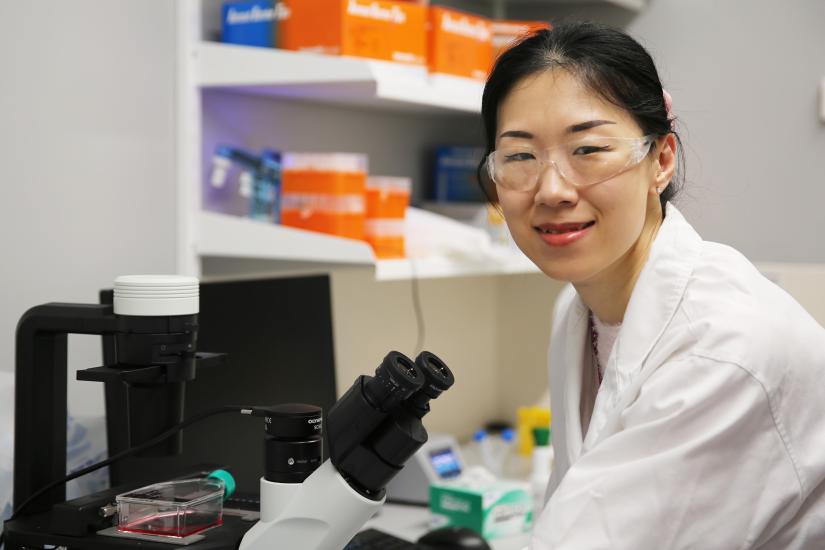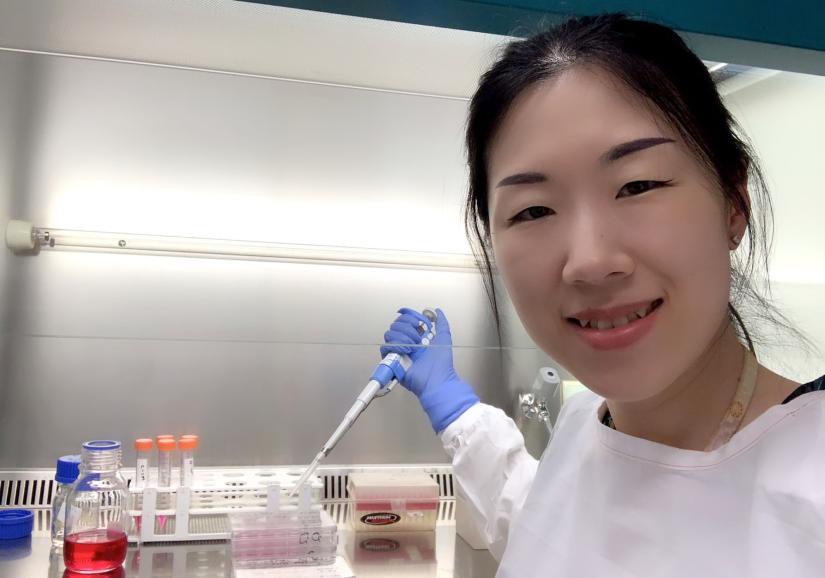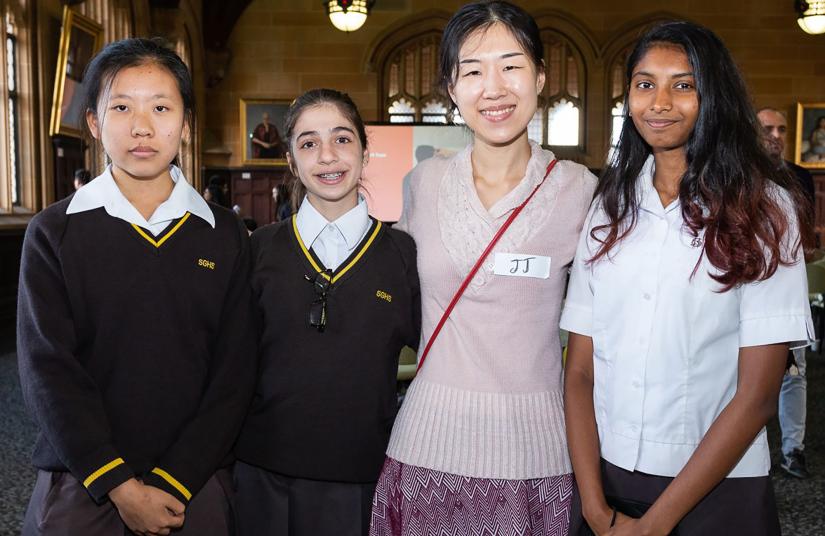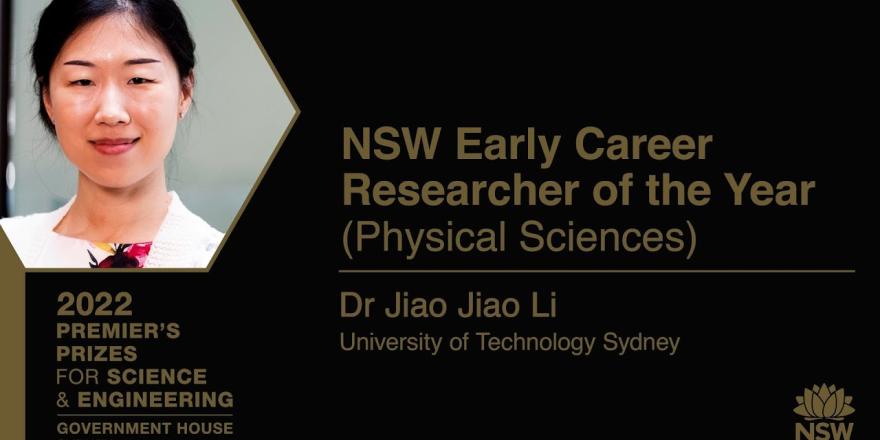Dr Jiao Jiao Li has won the Premier’s Prize for NSW Early Career Researcher of the Year (Physical Sciences), in addition to her being named the overall NSW Young Tall Poppy Scientist of the Year in 2022 for excellence in biomedical engineering. Dr Li is also a 2021-22 Superstar of STEM, which recognises her promotion of science among school students and the broader community.

Dr Jiao Jiao Li: ‘An engineer’s critical thinking and problem solving are essential for developing innovative technologies.’ Photo by Leilah Schubert
What are your areas of expertise and what are you working on now?
I trained as a biomedical engineer, and undertook my PhD and postdoctoral research in tissue engineering and regenerative medicine. This training has enabled me to work across many areas, from materials science and cell and molecular biology to nanotechnology and computer science.
I am now developing a new treatment therapy for osteoarthritis that makes use of the nanoscale packages produced by stem cells, which contain a wealth of bioactive factors. I am looking into optimising these as an off-the-shelf “magic potion” that is specifically effective for treating osteoarthritis. In parallel, I’m looking into biomaterial solutions to effectively deliver these into patients.
What excites you about it? Why is it important?
What is fascinating about tissue engineering and regenerative medicine in general is that the field is truly multidisciplinary, and the integration of ideas and techniques across disciplines really allows us to reach new frontiers in STEM. We are now at the brink of building whole organs and developing cures for previously incurable diseases – unimaginable a few decades back. In my research I interact with people all over the world, from researchers and clinicians to patients and the community. I’m so excited to be working in this field, with a specific interest in musculoskeletal tissues where associated chronic diseases cause lifelong disability in hundreds of millions of people globally. Osteoarthritis alone costs the Australian healthcare system more than $23 billion annually.
What has inspired you to pursue this career?
I have always been interested in STEM, but landed in a degree in biomedical engineering through sheer luck. During my HSC year, I was sitting in a lecture theatre at my first open day and saw a combined degree in biomedical engineering and medical science, and chose it because it sounded cool and I wasn’t too sure what I wanted to do. I would not change it for anything else now but it definitely wasn’t well thought out at the time. I think being an engineer sets me apart from being a scientist or medical specialist because we’re trained in critical thinking and problem solving, which is essential for developing innovative, pragmatic and transferrable technologies.
During my honours year I loved the experience of conducting a research project and having the intellectual freedom to find out new things. My first job was a marketing role at a biomedical devices company, which was a great experience, but it could not compare with the excitement I got out of my honours project. I saw that as a biomedical engineering researcher, I could be one of the people leading the development of new technologies that solve some of our greatest medical challenges. This motivated me to continue onto a PhD directly after my undergraduate degrees, and to pursue a career in research.

Dr Jiao Jiao Li working in the lab with stem cells she hopes will one day deliver a new therapy for osteoarthritis.
What have you learnt from your mentors?
Numerous amazing Australian women in STEM research currently mentor me in my career. My first mentor was my PhD supervisor Professor Hala Zreiqat, a driving force for me to continue in a research career. The most important lesson I have learnt from all my mentors is resilience and the ability to embrace failure. Rejections are so commonplace in a research career and I now see them as a positive motivation to take on greater challenges.
What barriers have you encountered in establishing your career?
Gender and cultural background as a female Chinese-Australian have definitely played a part in my ‘imposter syndrome’. I used to be afraid to put myself forward for opportunities and attributed a lot of my successes to luck rather than hard work. I am also the first-generation Australian and academic in my family, so there was a lot of figuring out to do both in integrating with Australian culture and navigating an academic career. Through the advice of my mentors and the Superstars of STEM program, I’m learning to break down these barriers, overcome the genetic conditioning and environmental influences that make me feel like I’m not doing good enough, and support my peers and younger women to do the same.
What have been your most rewarding achievements?
The most rewarding moments were critical in shaping my career journey and the work I’m doing today. The first was my university medal for coming first in the Bachelor of Biomedical Engineering at the University of Sydney and a prize from the Sydney Orthopaedic Research Institute for my top-ranked honours thesis. I think this affirmed my confidence in my academic ability and encouraged me to pursue a PhD. The second was receiving a NHMRC Early Career Fellowship after a difficult period of downtime following my PhD, which motivated me to continue a career in basic science research. The third was moving to UTS in 2020 to establish my own team and build an independent research program.
The most recent moments would be being selected as a Science & Technology Australia 2021-22 Superstar of STEM, winning Falling Walls Lab Australia 2021 and, of course, the 2022 NSW Young Tall Poppy Science Award. I have always had a passion for science communication and passing on the excitement of a STEM career to our next generation, particularly girls. These successes are giving me an elevated platform to reach more people in our community.

Dr Jiao Jiao Li, a mentor for the BIOTech Futures program, hopes to inspire school students to become tomorrow's STEM professionals.
What advice would you offer to school students, especially girls?
Do what interests you and don’t listen to voices internally or externally saying you’re not good enough or suited for it. It’s better to have tried and failed than not tried at all, because you gain the experience and have more people knowing that you’re trying. Look after yourself and reach out for help if you’re struggling. And, finally, STEM careers are awesome! We create life-changing solutions for our society, and everyone – regardless of our gender, cultural and other background – has a role to play.
What’s next?
I’m really looking forward to seeing ‘real people’ again, particularly international friends after so long. I hope to be able to advance our idea from proof-of-concept to an actual product, connect with more people along this journey, and also reach more of the community to promote STEM and represent our diversity.

JJ Li explaining her research and background as a biomedical engineer working in tissue engineering and regenerative medicine.
Dr Jiao Jiao Li is a Lecturer in the UTS School of Biomedical Engineering. In 2022, she has been awarded the Premier’s Prize for NSW Early Career Researcher of the Year (Physical Sciences) and NSW Young Tall Poppy Scientist of the Year, as well as being a Science & Technology Australia 2021-22 Superstar of STEM.
In 2021, Dr Jiao Jiao Li won the Falling Walls Lab Australia national competition and went on to compete in the world final, pitching her research into an off-the-shelf, stem cell-based therapy for osteoarthritis to an international jury at the Falling Walls Science Summit in Berlin.

